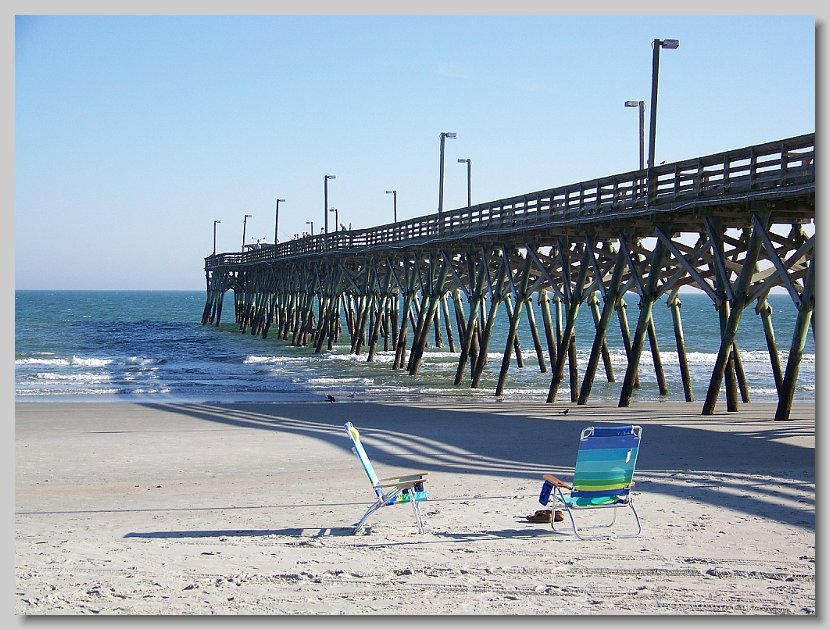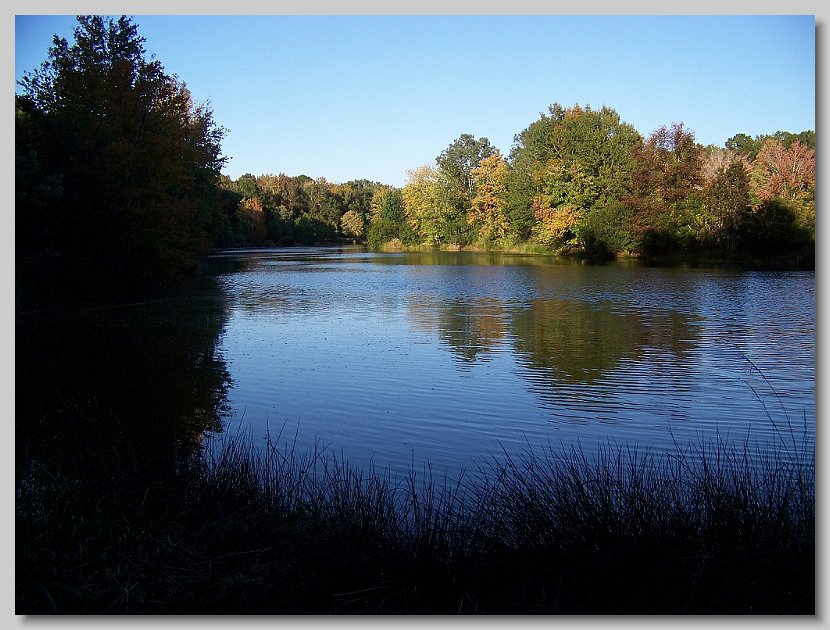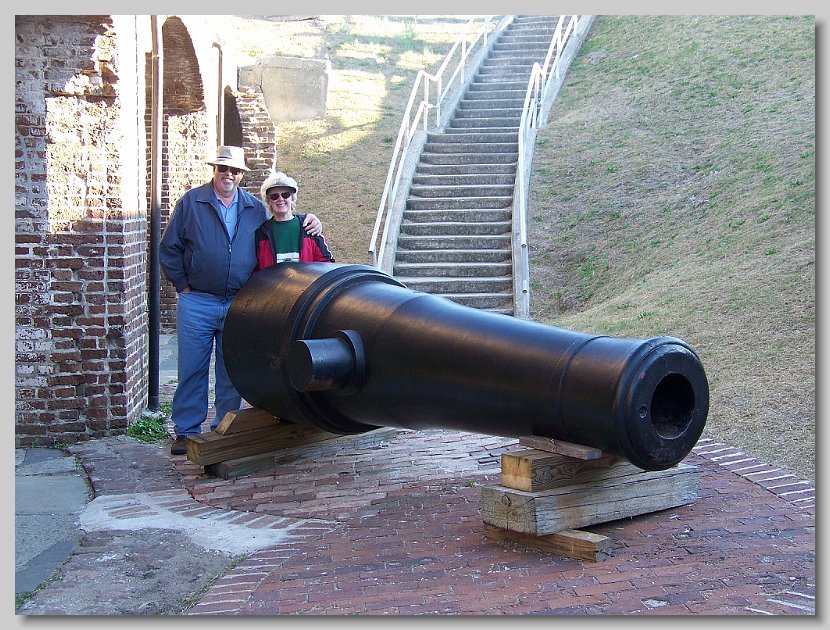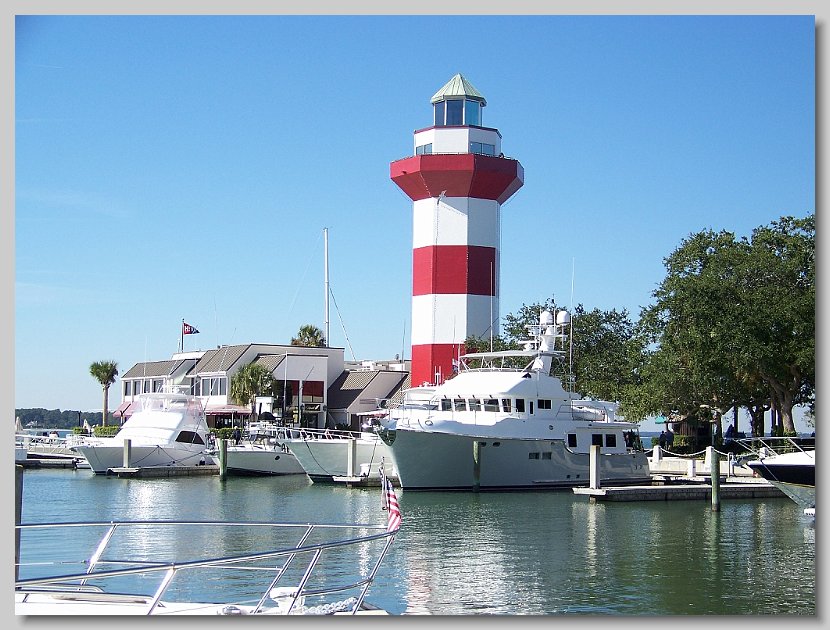
Nov 8-20 - South Carolina
We spent just 12 days in South Carolina, given our desire to avoid travel on Thanksgiving Day. The first week was in Myrtle Beach, just south of the North Carolina border, and our first actual close-up view of the Atlantic Ocean, followed by five days at Yemassee, SC - about 60 miles southwest of Charleston.
 Myrtle Beach is a full-blown, high-energy beach resort. Not much relaxing southern lifestyle here. They claim over 100 golf courses, but we think that includes lots of putt-putt courses. There are hundreds of restaurants of every kind. There are dozens of junky beach souvenir shops, two factory outlet malls with over 100 stores each, several Branson-style "music show houses", a couple of small amusement parks, miles of wonderful ocean beach, and enough condominiums to house a small country. We stayed at a delightful RV park at the north end of Myrtle Beach, an oasis in the midst of all that surprising bustle. We can only imagine what it's like at the height of the tourist season in July or August. And, of course, we ate way too much - there are so many great places to eat. Myrtle Beach is a full-blown, high-energy beach resort. Not much relaxing southern lifestyle here. They claim over 100 golf courses, but we think that includes lots of putt-putt courses. There are hundreds of restaurants of every kind. There are dozens of junky beach souvenir shops, two factory outlet malls with over 100 stores each, several Branson-style "music show houses", a couple of small amusement parks, miles of wonderful ocean beach, and enough condominiums to house a small country. We stayed at a delightful RV park at the north end of Myrtle Beach, an oasis in the midst of all that surprising bustle. We can only imagine what it's like at the height of the tourist season in July or August. And, of course, we ate way too much - there are so many great places to eat.
A Myrtle Beach tradition is the Calabash Seafood Buffet - and there are several places advertising all you can eat 100+ item seafood buffets. We checked out some on-line reviews before picking one buffet, as much for the experience as for the food. One of the buffet reviews said it best - "If you like seafood, go to a seafood restaurant. If you like all you can eat, but don't much care what you eat, go to a buffet." We're glad we went to Crabby Mike's buffet, but we never get our money's worth at an all-you-can-eat anything. We both came away stuffed, Judy primarily with crab legs, which she said were quite good.
 We'd have liked to stay closer to Charleston, but couldn't find a place to park the motorhome that was both affordable and available, so we parked at a place called Pointe South, about 60 miles from Charleston and 40 miles north of the Georgia line. The Oaks RV Resort is all trees, and we had no clear sky to point our satellite dish at. So we did without TV, but also did manage to watch the extended versions of the first two Lord of the Rings movies. Being away from the places we wanted to visit meant a lot of day trips - twice to Charleston, once to Hilton Head Island, where Al lived in the late 70s and early 80s. We'd have liked to stay closer to Charleston, but couldn't find a place to park the motorhome that was both affordable and available, so we parked at a place called Pointe South, about 60 miles from Charleston and 40 miles north of the Georgia line. The Oaks RV Resort is all trees, and we had no clear sky to point our satellite dish at. So we did without TV, but also did manage to watch the extended versions of the first two Lord of the Rings movies. Being away from the places we wanted to visit meant a lot of day trips - twice to Charleston, once to Hilton Head Island, where Al lived in the late 70s and early 80s.
Our first visit to Charleston involved a visit to Fort Sumter, where the first shots of the Civil War were fired. Either we've forgotten a lot, or there's a lot we never learned about Fort Sumter in school. Fort Sumter sits on an artificial island at the mouth of Charleston Harbor, one of a string of coast defense forts ordered built by President Thomas Jefferson after the war of 1812. The fort was never completed, and when South Carolina became the first state to secede late in 1860, a force of just 85 US soldiers moved from the mainland to the island fort, believing it to be easier to defend. The South Carolina Militia spent a few months staging several thousand troops on the mainland overlooking the fort while demanding that the US troops surrender. By April of 1861, the US troops were still there, so South Carolina opened fire - the first shots of the Civil War. After two days, the US troops withdrew to a ship, and gave up the fort. About this time, the Confederacy was formed, and Confederate troops occupied the fort, and commenced to finish it and arm it.
 A primary Union war strategy involved a blockade to keep the Confederacy from shipping anything in or out, and Charleston harbor was a major hole in that blockade. It didn't take long for the Union forces to capture the headlands around the fort, and begin a bombardment that lasted until the end of the war. The Union army shot 2.5 million pounds of shells at and into the fort. The fort was essentially leveled, but the Confederate troops never surrendered, and the Charleston harbor was able to ship goods out and war supplies in. Once the Civil War ended, the fort was largely abandoned until the Spanish-American War, when it was spiffed up and outfitted with "modern" weapons just in time for the end of the war. Anyhow, most of that is stuff we never knew (or had long ago forgotten), and it was and is fascinating to us. A primary Union war strategy involved a blockade to keep the Confederacy from shipping anything in or out, and Charleston harbor was a major hole in that blockade. It didn't take long for the Union forces to capture the headlands around the fort, and begin a bombardment that lasted until the end of the war. The Union army shot 2.5 million pounds of shells at and into the fort. The fort was essentially leveled, but the Confederate troops never surrendered, and the Charleston harbor was able to ship goods out and war supplies in. Once the Civil War ended, the fort was largely abandoned until the Spanish-American War, when it was spiffed up and outfitted with "modern" weapons just in time for the end of the war. Anyhow, most of that is stuff we never knew (or had long ago forgotten), and it was and is fascinating to us.
Our second day trip to Charleston was to tour Boone Hall Plantation, billed as "The Most Photographed Plantation in South Carolina". We probably could have chosen our plantation based on better criteria, but it was still a neat tour.
 Hilton Head Island was almost a shock. When Al left in 1983, the island population was about 7,500 full time, and about 90,000 during the tourist season. Today it has a permanent population of about 40,000, there's at least that many folks who live in "Hilton Head Communities" on the mainland, and the seasonal population is over 250,000. And while the island has managed to retain the illusion of being a natural environment, with lots of trees and green, it is still very densely populated. There are dozens of golf courses, hundreds of restaurants, and plenty of multi-million dollar homes tucked behind the gates of the "plantations". It was nice to visit, but only just vaguely familiar. There's a Wal-Mart now, and almost none of the businesses have familiar names. We did manage to find the two houses Al lived in while there, and the remains of the radio station he managed. It's still a very pretty place, but it doesn't feel at all the same. Hilton Head Island was almost a shock. When Al left in 1983, the island population was about 7,500 full time, and about 90,000 during the tourist season. Today it has a permanent population of about 40,000, there's at least that many folks who live in "Hilton Head Communities" on the mainland, and the seasonal population is over 250,000. And while the island has managed to retain the illusion of being a natural environment, with lots of trees and green, it is still very densely populated. There are dozens of golf courses, hundreds of restaurants, and plenty of multi-million dollar homes tucked behind the gates of the "plantations". It was nice to visit, but only just vaguely familiar. There's a Wal-Mart now, and almost none of the businesses have familiar names. We did manage to find the two houses Al lived in while there, and the remains of the radio station he managed. It's still a very pretty place, but it doesn't feel at all the same.
We left SC two days before Thanksgiving and moved just 60 miles to Skidaway Island, outside Savannah, GA, where we'll spend Thanksgiving and see more sights. Stay tuned.
We've posted a few more than 100 pictures we took in South Carolina. You'll find them here.
|
